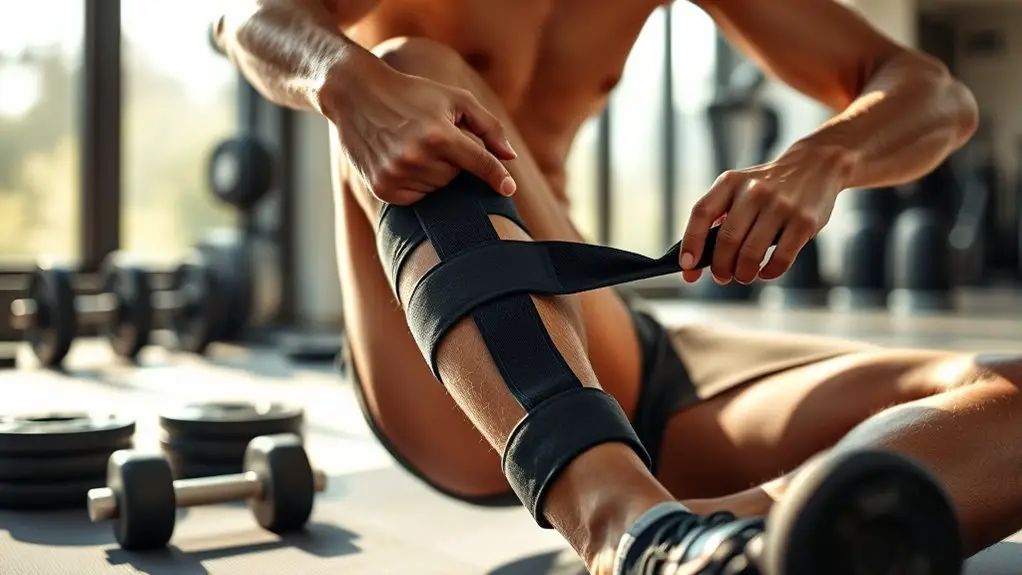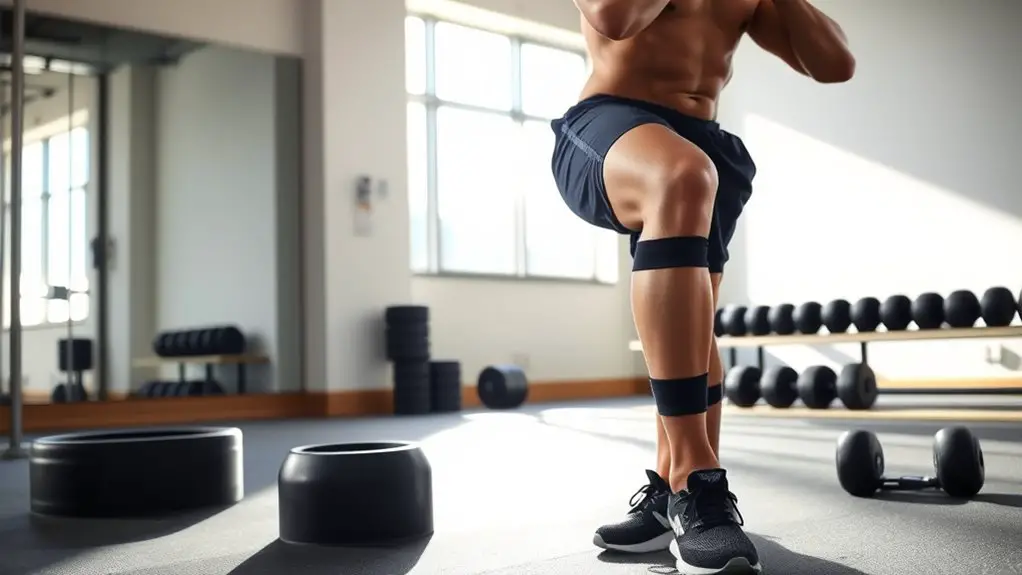How to Train With Knee Pain at the Gym

If you’re dealing with knee pain, focus on low-impact exercises like cycling and swimming to reduce strain. Modify your workout by incorporating resistance bands and gentle strength training, while prioritizing proper form. Stretch regularly to improve flexibility and alleviate discomfort. Use supportive gear, like knee braces and proper footwear, to enhance stability. Always listen to your body’s signals and progress safely. There’s plenty more to explore about effective training adjustments that keep you active without aggravating your knees.
Understanding Knee Pain and Its Causes

When you experience knee pain, it can be frustrating, especially if you’re keen to stay active. Understanding the causes of your discomfort is essential for effective management. Start by identifying symptoms like swelling, stiffness, or a popping sound when moving your knee. These signs can help you pinpoint common injuries such as tendonitis, bursitis, or ligament tears.
Knee pain often stems from overuse, improper technique during workouts, or a sudden increase in activity level. It’s important to listen to your body and recognize when something feels off. Ignoring these symptoms can lead to more severe injuries, hindering your ability to stay fit.
Consulting a Healthcare Professional
If you’ve been dealing with knee pain, consulting a healthcare professional should be your next step. A medical evaluation is essential to determine the underlying issues causing your discomfort. By seeking professional advice, you can explore appropriate treatment options tailored to your needs. Here are four important reasons to consult a healthcare provider:
Consulting a healthcare professional is key to diagnosing and managing your knee pain effectively.
- Accurate Diagnosis: They can identify the specific cause of your knee pain.
- Customized Treatment: A professional can suggest personalized treatment options, including physical therapy or medications.
- Injury Prevention: They’ll provide guidance on how to avoid further injuries during your workouts.
- Long-Term Management: You’ll learn strategies for managing your knee pain effectively over time.
Modifying Your Workout Routine

How can you continue to stay active while managing knee pain? The key is making smart knee modifications in your workout routine. Start by identifying exercises that place less stress on your joints. Instead of traditional squats, try wall sits or seated leg lifts. These workout alternatives can help you strengthen your muscles without aggravating your knee.
You might also consider using resistance bands for strength training. They provide support and allow for controlled movements. When it comes to flexibility, focus on gentle stretching routines that keep your knees stable. Incorporating proper technique in your exercises can help minimize stress on your knees and reduce the risk of injury.
It’s essential to listen to your body. If something doesn’t feel right, don’t hesitate to adjust or skip that exercise. Incorporating these modifications can help you maintain your fitness while ensuring your knees stay safe. Remember, staying active is possible with the right approach, so prioritize your safety above all.
Low-Impact Cardio Options
When you’re managing knee pain, finding the right low-impact cardio options can make a big difference. Cycling offers great benefits for your knees, while swimming provides excellent joint relief. Exploring these activities can help you stay active without causing discomfort, and incorporating low impact alternatives like exercise bands can further enhance your workout routine.
Cycling Benefits for Knees
Although knee pain can be a frustrating barrier to maintaining an active lifestyle, cycling offers a low-impact cardio option that can actually benefit your joints. By using proper cycling techniques and confirming you have adequate knee support, you can enjoy the following advantages:
- Reduced Impact: Cycling exerts less stress on the knees compared to running or jumping.
- Strengthening Muscles: It helps build the muscles around your knees, providing better support.
- Improved Flexibility: Regular cycling promotes joint flexibility, enhancing your range of motion.
- Cardiovascular Health: It boosts your overall fitness while being gentle on your knees, making it safer for those with pain.
Always consult a healthcare professional before starting any new exercise routine to confirm it’s right for you.
Swimming for Joint Relief
If you’re looking for a low-impact cardio option that provides joint relief, swimming might be the perfect choice. The buoyancy benefits of water reduce strain on your knees, allowing for a safer workout. Water aerobics is particularly effective, as it combines resistance and cardio without the pounding of traditional exercises.
Here’s a quick comparison of swimming options:
| Activity | Joint Impact | Benefits |
|---|---|---|
| Freestyle Swim | Low | Full body workout |
| Water Aerobics | Very Low | Fun and social |
| Aqua Jogging | Low | Burns calories |
| Backstroke Swim | Low | Strengthens back |
| Breaststroke Swim | Low | Improves flexibility |
Enjoy the gentle yet effective nature of swimming while protecting your joints!
Strength Training for Knee Stability

When it comes to knee stability, you can’t underestimate the role of core strength. Incorporating low-impact exercises with proper form and technique can make a big difference in how your knees feel during workouts. Jumping rope may also be beneficial for overall fitness and knee health when performed correctly, providing an effective way to enhance strength and coordination.
Importance of Core Strength
While many people focus solely on leg strength for knee stability, the core plays an essential role in maintaining proper alignment and support during movement. By enhancing your core stability and core activation, you can greatly reduce the risk of further knee injury. Here are four reasons why core strength is crucial for knee health:
- Improved Balance: A strong core helps maintain balance, reducing the strain on your knees.
- Enhanced Posture: Proper alignment minimizes unnecessary stress on the knee joint.
- Increased Stability: Core strength stabilizes your entire body, allowing for safer movement patterns.
- Reduced Injury Risk: A strong core can help prevent compensatory movements that might lead to injuries.
Focusing on your core will ultimately support your knees during workouts.
Low-Impact Exercises Recommended
To maintain knee stability without aggravating pain, incorporating low-impact exercises into your routine is essential. Focus on rehabilitation exercises that strengthen the muscles around your knee while being gentle on your joints. Consider activities like swimming, cycling, or using an elliptical machine, which provide effective cardio options without the harsh impact.
Strength training can also be beneficial; try exercises like leg presses or seated leg curls. These joint-friendly workouts allow you to build strength safely. Remember to listen to your body—if something doesn’t feel right, modify the exercise or choose an alternative. The goal is to enhance stability and support your knees while minimizing discomfort, ensuring your workouts remain both effective and safe.
Proper Form and Technique
Proper form and technique are essential for anyone looking to strengthen their knees without exacerbating pain. Focus on maintaining proper knee alignment during exercises, and don’t hesitate to make exercise modifications if needed. Here are some key points to remember:
- Engage Your Core: A strong core supports proper alignment and stability.
- Use Controlled Movements: Avoid sudden jerks; slow and steady helps protect your knees.
- Position Your Feet: Keep your feet shoulder-width apart to promote knee stability.
- Listen to Your Body: If something feels off, stop and reassess your form or try a modification.
Stretching and Flexibility Exercises
Incorporating stretching and flexibility exercises into your routine can greatly alleviate knee pain and enhance overall mobility. Start with dynamic stretching before your workouts; movements like leg swings and high knees can warm up your muscles and prepare your joints, reducing the risk of injury. It’s essential to avoid overstretching, so listen to your body and only push to a comfortable limit.
After your workout, engage in flexibility routines that focus on the quadriceps, hamstrings, and calves. Gentle static stretches, held for 15-30 seconds, help improve flexibility and promote recovery. Remember to breathe deeply and relax into each stretch, avoiding any sharp pain.
Using Proper Equipment and Support
Wearing the right equipment can make a significant difference in managing knee pain during your workouts. Investing in appropriate gear not only enhances your performance but also guarantees your safety. Here are four essential items to take into account:
Wearing the right equipment is crucial for managing knee pain and ensuring safety during workouts.
- Knee Braces: These provide stability and support, helping to reduce strain on your knees during various exercises.
- Supportive Footwear: Choose shoes designed for your specific activity, offering cushioning and proper arch support to minimize impact on your knees. Slip-On Vans can be suitable for lifting if they fit well, offering a stable base for exercises.
- Foam Rollers: Use these to release muscle tension and improve flexibility, aiding in overall knee health.
- Resistance Bands: Incorporate these into your routine to strengthen the muscles around your knees while minimizing joint stress.
Listening to Your Body and Progressing Safely
While it’s important to stay active, you must listen to your body and recognize when something feels off, especially if you’re dealing with knee pain. Developing body awareness is essential; pay attention to any discomfort or unusual sensations during your workouts. If you feel sharp pain or persistent discomfort, it’s imperative to stop and reassess your routine.
Safe progression is key to preventing further injury. Instead of pushing through the pain, focus on gradual increases in intensity and volume. Start with low-impact exercises and slowly integrate more challenging movements as your knee tolerates them. Keep a record of your workouts to track how your body responds over time.
Consulting a healthcare professional can also provide guidance tailored to your needs. Prioritize your safety, and remember that taking a step back can lead to a stronger, healthier you in the long run.
Frequently Asked Questions
Can I Still Play Sports With Knee Pain?
If you’ve got knee pain, it’s important to be cautious about sports participation. While you might want to keep playing, pushing through pain could lead to further injury. It’s best to consult a healthcare professional to assess your condition. They can provide guidance on whether it’s safe for you to continue playing. If you do play, consider modifying your activities to reduce stress on your knees and prioritize recovery.
What Role Does Diet Play in Knee Pain Management?
When managing knee pain, your diet’s essential. Anti-inflammatory foods, like fatty fish, nuts, and leafy greens, can help reduce inflammation and promote healing. Staying hydrated’s equally important, as it keeps your joints lubricated and functioning well. By choosing the right foods and maintaining proper hydration, you create a supportive environment for your knees, allowing you to feel better while minimizing discomfort. So, focus on nutrition to aid in your recovery journey.
Are There Specific Supplements for Joint Health?
When considering specific supplements for joint health, you might want to look into glucosamine benefits. It’s known to support cartilage health and may reduce pain. Turmeric effects are also significant; its anti-inflammatory properties can help alleviate joint discomfort. Always consult with a healthcare professional before starting any new supplement, as they can provide personalized advice and guarantee your safety while you address your joint health concerns effectively.
How Can I Prevent Future Knee Injuries?
It’s like trying to navigate a minefield without a map—preventing future knee injuries requires careful planning. You’re gonna want to focus on strengthening exercises that target your leg muscles, as stronger muscles support your knees better. Don’t forget proper footwear; shoes with good arch support can make a world of difference. Stay mindful of your movements, and listen to your body to avoid overdoing it. Safety first, and your knees will thank you!
When Should I Seek Surgery for Knee Pain?
When you’re dealing with persistent knee pain, it’s vital to recognize the surgery indicators. If your pain isn’t improving despite conservative treatments, or if you’re experiencing swelling, instability, or difficulty with daily activities, it might be time to consult a specialist. They’ll help assess your situation and discuss a potential recovery timeline. Remember, addressing issues early can prevent further damage and guarantee a safer, more effective recovery process.





